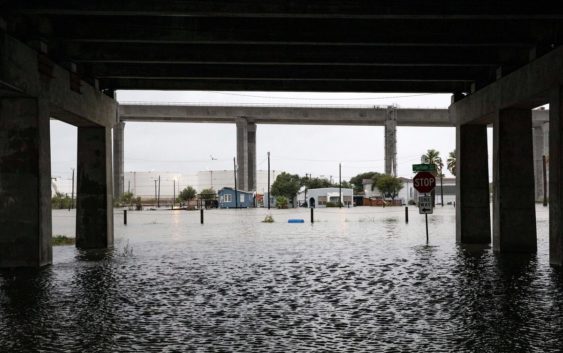- Sellers and Rantanen are among the NHL trade deadline winners. Hurricanes and Boeser are some losers
- Hurricane forecasters express concern over NOAA job cuts impact
- FEMA deadline for Hurricane Helene recovery aid extended again
- Tornado drills to take place at schools across North Carolina Friday morning
- Hays County emergency alerts cause confusion during Tuesday's wildfires
What happens when a hurricane hits a coronavirus hot spot? South Texas cities found out the hard way.

Sign up for The Brief, our daily newsletter that keeps readers up to speed on the most essential Texas news.
Before Hurricane Hanna dumped at least 15 inches of rain on the South Texas city of Mission, the City Council there approved taking out a $5 million bank loan to ensure the city’s stockpile of equipment to protect against the new coronavirus was sufficient.
Having enough face masks, sanitizers, gloves and other personal protective equipment is key to preparing for storms during the coronavirus pandemic, Mission Mayor Armando O’Caña said. But governments are struggling for revenues to stock enough equipment during the economic recession caused by the pandemic, and O’Caña said the city was also forced to dip into its cash reserves.
“I have to use my reserves, and I actually have to borrow money from the bank in the form of a short-term loan,” O’Caña told the Texas Tribune. “But I got to do what I got to do for the city of Mission to survive.”
Now, O’Caña said, the city needs to restock its supply, yet another unusual task for local officials this hurricane season, which has another four months remaining. Preparing for a natural disaster is always challenging, but doing so during the pandemic has been a tough task across South Texas, already a deadly coronavirus hot spot, and along the rest of the Gulf Coast as residents and officials continue preparing for what forecasters predict will be an unusually active hurricane season.
The Texas Division of Emergency Management has assisted with response to the storm in Mission and across the impacted region, outfitting responders with personal protective equipment the state has purchased, according to agency spokesperson Seth Christensen. Emergency shelters have been tweaked to abide by health guidelines, and some of those shelters will wind up being hotels.
Before storms make landfall this season, Christensen said the agency is distributing the protective equipment to its nearby warehouses to “get it as close to the impact zone as we can and be able to push it in as soon as possible.”
“We’re used to staging resources before a hurricane, we’re used to staging boats and rescue equipment,” Christensen toldThe Texas Tribune. “For this event, we had to add on not only the number of resources but also start staging things like PPE that we haven’t necessarily had to distribute to the public in the past.”
The agency has also had to adapt how it provides shelter for individuals who are forced to evacuate their residences, which Gov. Greg Abbott noted during a news conference Tuesday in Corpus Christi, near where Hurricane Hanna made landfall Saturday.
“During a time of having a hurricane while also in the midst of an infectious disease pandemic, people gathering in shelters is a particularly compromised situation,” said Abbott, who surveyed Hanna’s damage from the air and met with local officials on the ground.
The state, in partnership with organizations like the American Red Cross, has had to adjust its shelter sites because of the coronavirus. The state emergency responders have provided face masks, sanitizers and temperature checks for evacuees at shelter sites in order to prevent transmission of the coronavirus, Christensen said.
“You can’t put a large mass of people into a small space,” Christensen said. “You have to prepare for social distancing and follow [Centers for Disease Control and Prevention] guidelines and local health guidance.”
The agency and the Red Cross have partnered with hotels to temporarily house evacuees, as the normal shelter situations in convention centers or sports stadiums will not be able to hold as many people due to social distancing guidelines, Christensen said.
“We have to have more space for each individual,” he said. “We’re also using noncongregate shelters — we’re utilizing hotels. We’re going to be able to keep families together in hotels so they’re not mixing and mingling with other families and individuals, to prevent the spread of COVID-19.”
The Rio Grande Valley, however, didn’t see large amounts of evacuees at shelters, said Kevin Pagan, McAllen’s emergency management coordinator.
“I think some of it was attributable to people being very reluctant to go to some place with a bunch of people they don’t know overnight,” Pagan told The Texas Tribune.
Pagan said he learned some lessons from the the state’s first major storm during the coronavirus and had a tip for any officials preparing for the next one.
“Make sure you’ve got your shelter situation ironed out and the messaging about your shelter situation is clear,” Pagan said.